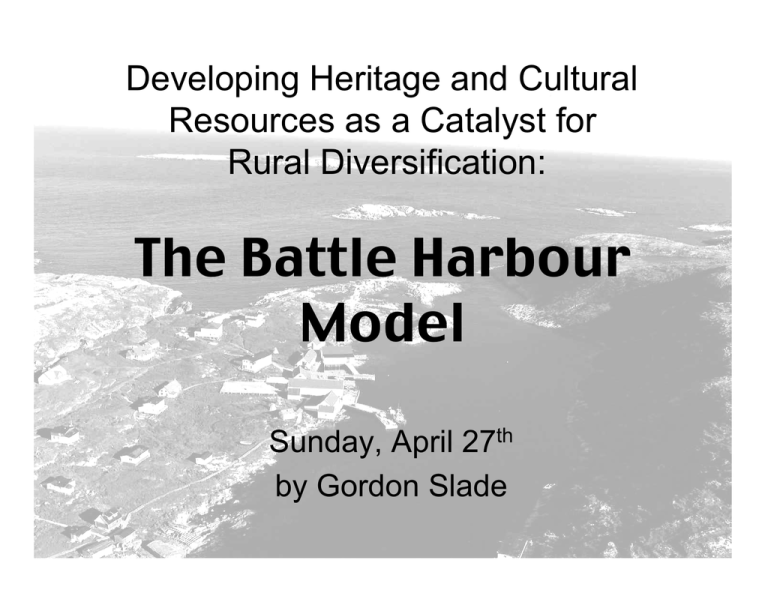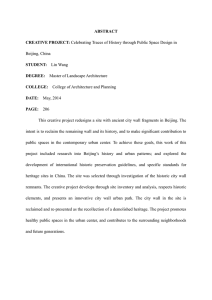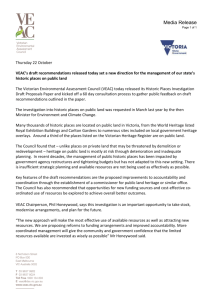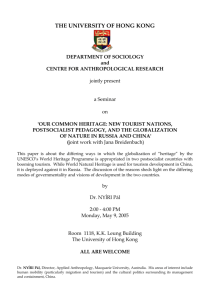The Battle Harbour Model Developing Heritage and Cultural Resources as a Catalyst for
advertisement

Developing Heritage and Cultural Resources as a Catalyst for Rural Diversification: The Battle Harbour Model Sunday, April 27th by Gordon Slade Location of Battle Harbour Battle Harbour’s Cultural Heritage Resources • fishing premises and berths • fishing boats, stages, flakes, seines and fishing implements • artifacts of the salt fish era • artifacts of a way of life living on the headlands • oral and written history • evidence of aboriginal settlements • evidence of early European explorers and settlers • merchants and their enterprises What is the vision? • To bring to life an 18th century northern fishing station representative of early English migratory fishing as well as the early settlers from Newfoundland, the US and Canada to pursue cod. • For this restored Heritage site to receive national and international recognition as a tourism destination How do you achieve that vision? • Community involvement and ownership of the project; • Acquire cultural resource management expertise; • Develop and implement a strategic management plan and marketing concept; • Restoration, preservation and conservation of the architecheral heritage properties; • Develop partnerships with organizations, agencies and governments to finance and promote the site. What principles should guide your development? • Minimum level of intervention to restore the properties. • Protection of the environment is essential. • Ensure local involvement in all stages of development. • Professional cultural resource expertise in all activities. Local Involvement with professional expertise is essential • The benefits from the site should all accrue to local residents • Employment should be 100% local if possible • All goods & services acquired locally if possible • Youth from local communities should be involved as student workers on the site • Community heritage organization should be established to carry out research and educate local people on their heritage resources. What role can governments play? • Assist with the acquisition of the property. • Provide financial resources to carry out research. • Provide financial resources to develop the properties. • Provide financial resources to hire professional project staff. • Establish site under the provincial historic sites program. Changing Phases: Study & Planning → Business • A strategic management plan will suggest what sustainable development will be required to be completed. • A business plan. • Staff needs to be recruited and trained to manage the business. What has been accomplished over the past 12 years? • More than 20 buildings have been restored as well as wharves and walkways. • More than $5 million has been injected in the local economy. • 20 heritage carpenters have been trained. • A new business has been created. • Local businesses have expanded. • The last remaining salt fish mercantile premises in North America has been saved for future generations. • 1000’s of artifacts of the salt fish era have been catalogued and displayed. • A major interpretation centre for the salt fish era has been established. • Historic homes are now available for visitors to stay in. • The site has been designated with National Historic Significance and a National Historic District by the Historic Sites and Monuments Board of Canada. • A core workforce of 10 people are now engaged on a seasonal basis at Battle Harbour. • Battle Harbour will become a research node in the Labrador Sea for Memorial University through the Labrador Institute of MUN. • The site has been recognized by National Geographic and Conservation International as one of the important heritage tourism sites in the world. • The site has been recognized by the Smithsonian Magazine and the United States tourism Operator Association. • This year the foundation received the Manning Award in the International category. • Battle Harbour has been a catalyst to get the Southern Labrador Research Initiative underway. This project will see researchers from many disciplines initiate research in southern Labrador to improve the economic prospects of communities from L’Anse au Clair to Cartwright. Where do I see the site going in the future? • Battle Harbour will: – Produce heritage products which will be sold year round produced by local people. – Become a research node for universities and colleges to do research field work in the Labrador Sea. – Be a retreat for artists who want to bring students to the site for seminars and workshops. This activity will start in 2004 by the noted Canadian photographic Michael Beedel. – Be recognized as a model community utilizing the most environmentally friendly technology and practices for a northern location – Become part of the provincial and/or federal historic site program







